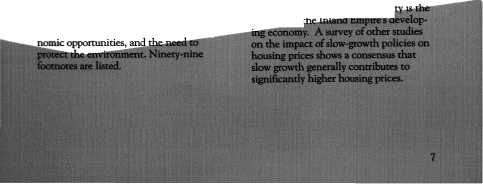$\ movement consider a*
# 'Ath-control the of
and the for
i,r< Jevelopment. Suburban
has by a vision of the
<uhurK as a with preferred housing,
where children
on and communities that are
on and communities that are
Low commercial
anj a for low-density li\ ing
also suborbs grow rapidly,
with suburban growth include
a strain on the
infrastructure.
infrastructure.
The slow-growth movement, with its
in the 1960s and 1970s, links the
in the 1960s and 1970s, links the
of environmentalists and home-
who want to protect their proper-
ty Controls designed to limit
who want to protect their proper-
ty Controls designed to limit
may have the effect of reducing
for low-income and moderate-
households, which in turn
their access to the advantages of
communities and jobs.
for low-income and moderate-
households, which in turn
their access to the advantages of
communities and jobs.
The exclusionary effects of growth con-
have been challenged under the
equal-protection and due-process clauses
equal-protection and due-process clauses
14th amendment, but the results
are mixed. Policies that manage growth
are mixed. Policies that manage growth
a balance among the tradi-
American values of the right to
property* die expansion of eco-
American values of the right to
property* die expansion of eco-
Growth
in the
in the
Hayward
16pp.
16pp.
for $5 the
Arrow Highway D6 CA
91763? (714) 621-6825
This study how slow-
growth policies would affect economic
growth in the Inland Empire* which is
the valley area between Kellogg Hill in
Los Angeles County and Banning Pass,
Most of the go\emment economic data
used for this study is for the Riverside-
San Bernardino-Ontario Standard
Metropolitan Statistical Area.
growth in the Inland Empire* which is
the valley area between Kellogg Hill in
Los Angeles County and Banning Pass,
Most of the go\emment economic data
used for this study is for the Riverside-
San Bernardino-Ontario Standard
Metropolitan Statistical Area.
While the rapid growth of the Inland
Empire has fueled some sentiment for
enacting slow-growth policies for the
region, this study argues that growth-
control policies affecting the building
industry would have a significant nega-
tive effect on the entire area's economy.
A U.S. Department of Commerce model
Empire has fueled some sentiment for
enacting slow-growth policies for the
region, this study argues that growth-
control policies affecting the building
industry would have a significant nega-
tive effect on the entire area's economy.
A U.S. Department of Commerce model
for regional economic activity, RIMS 11,
demonstrates that building activ|
m .. . — *> ^*i* .,£
m .. . — *> ^*i* .,£
linchpin of 1
